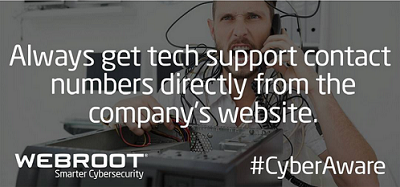If you have allowed remote access to your computer there is a good chance your security is jeopordized. I am sharing with you what I experienced to help. One of the Webroot Secure Anywhere Technicians told me that Webroot receives more complaints about this than receiving a virus. There is an upswing is this type of sneaky phishing!
Once you allow remote access to your computer that person keeps access even if you restore your computer days before. This means that even if you change your passwords it won't suffice. This person can access your computer even if it is off.
I made this mistake and left my email browswer open and while the alleged legitimate technician who was supposed to help me was being the scenes using my email and posing as me. I then got emails saying my enrollment was successful.
I lost two nights sleep until I called my bank who explained all of the above and then recommended I contact my online service provider to have them remove this remove access. So I call my internet provider and they spent over an hour asking me questions and trouble shooting my computer. The technician removed the remote access, removed one threat, removed 800 empty folders, and did a tune-up. I now have on my desktop this ToolBox at my use anytime I want and also can call the internet tech rep anytime. The service includes up to 3 computers. The cost is only $15 a month. It is peace of mind for me.
Once I did this my bank provided me a generic password that I reset. Once I did this the Bank Fraud Rep said that if anything happened to my bank accounts the bank will cover me. Had I not done this the bank would not be liable. I called the bank back to thank them especially this Bank Fraud Rep who assisted me and now is my hero. I forgot her name.
I must admit it was my fault this happened. The bank rep said she did the same thing once, too.
When this sneaky bad person was remoting to my computer and doing bad stuff Webroot Secure Anywhere was protecting me because a popup appeared and read, "do not proceed - malware/virus, etc." The $#^&*! person allowed these bugs onto my computer and that was my tipoff! I kick him/her off however the damage was done.
The bank rep asked me if anyone called me asking for a refund, asking for money, etc. No one did however I received an email that said this was a complimentary one time service.
By the way, before I allowed remote access guess how many people showed ahead of me? 55 people and some luckily hung up because the wait time for me was 30-45 minutes.
I hope this helps someone then it is all worthwhile. Please let me know if this is helpful.
Have you recently had any problems like this and what did you do?
Thanks in advance and I appreciate Webroot Secure Anywhere and this community support forum.
This is what we post about Fake tech support! So yes it's easy to get Scammed and people need to be aware of such things!
Thanks,
Daniel
THIS IS A SCAM!! Neither Microsoft nor any other company sends emails, pop ups, or phone calls of any kind advising that you may have a problem.
If you clicked on any links, allowed them to remote into your computer, or went to any websites please Submit a Support Ticket ASAP. (Now would be a good idea....)
If you would like more information, read on (After submitting that Trouble Ticket.....)
NEWS ARTICLE: Tech Support Scams are on the rise.
Microsoft never issues this type of warning or email or anything of a sort! Please see the following link for Microsoft's official word on this:
http://www.microsoft.com/security/online-privacy/avoid-phone-scams.aspx
"Neither Microsoft nor our partners make unsolicited phone calls (also known as cold calls) to charge you for computer security or software fixes.
Cybercriminals often use publicly available phone directories so they might know your name and other personal information when they call you. They might even guess what operating system you're using.
Once they've gained your trust, they might ask for your user name and password or ask you to go to a website to install software that will let them access your computer to fix it. Once you do this, your computer and your personal information is vulnerable."
Also see Avoid scams that use the Microsoft name fraudulently
http://www.microsoft.com/security/online-privacy/msname.aspx
For more information here's what the United States Federal Trade Commission has to say on the subject::
http://www.consumer.ftc.gov/articles/0346-tech-support-scams
"In a recent twist, scam artists are using the phone to try to break into your computer. They call, claiming to be computer techs associated with well-known companies like Microsoft. They say that they've detected viruses or other malware on your computer to trick you into giving them remote access or paying for software you don't need.
These scammers take advantage of your reasonable concerns about viruses and other threats. They know that computer users have heard time and again that it's important to install security software. But the purpose behind their elaborate scheme isn't to protect your computer; it's to make money."
This scam is common and has been around for quite a while. Here is a good Webroot Blog article from April 2013 by Threat Researcher Roy Tobin.
http://www.webroot.com/blog/2013/04/30/fake-microsoft-security-scam/
Also add a good free Ad Blocker like the ones suggested below:
For Internet Explorer Ad Block Plus: https://adblockplus.org/
For Firefox uBlock Origin: https://addons.mozilla.org/en-US/firefox/addon/ublock-origin/?src=ss or Privacy Badger: https://addons.mozilla.org/en-us/firefox/addon/privacy-badger-firefox/
Google Chrome uBlock Origin: https://chrome.google.com/webstore/detail/ublock-origin/cjpalhdlnbpafiamejdnhcphjbkeiagm?hl=en or Privacy Badger: https://chrome.google.com/webstore/detail/privacy-badger/pkehgijcmpdhfbdbbnkijodmdjhbjlgp
Thanks,
Daniel
THIS IS A SCAM!! Neither Microsoft nor any other company sends emails, pop ups, or phone calls of any kind advising that you may have a problem.
If you clicked on any links, allowed them to remote into your computer, or went to any websites please Submit a Support Ticket ASAP. (Now would be a good idea....)
If you would like more information, read on (After submitting that Trouble Ticket.....)
NEWS ARTICLE: Tech Support Scams are on the rise.
Microsoft never issues this type of warning or email or anything of a sort! Please see the following link for Microsoft's official word on this:
http://www.microsoft.com/security/online-privacy/avoid-phone-scams.aspx
"Neither Microsoft nor our partners make unsolicited phone calls (also known as cold calls) to charge you for computer security or software fixes.
Cybercriminals often use publicly available phone directories so they might know your name and other personal information when they call you. They might even guess what operating system you're using.
Once they've gained your trust, they might ask for your user name and password or ask you to go to a website to install software that will let them access your computer to fix it. Once you do this, your computer and your personal information is vulnerable."
Also see Avoid scams that use the Microsoft name fraudulently
http://www.microsoft.com/security/online-privacy/msname.aspx
For more information here's what the United States Federal Trade Commission has to say on the subject::
http://www.consumer.ftc.gov/articles/0346-tech-support-scams
"In a recent twist, scam artists are using the phone to try to break into your computer. They call, claiming to be computer techs associated with well-known companies like Microsoft. They say that they've detected viruses or other malware on your computer to trick you into giving them remote access or paying for software you don't need.
These scammers take advantage of your reasonable concerns about viruses and other threats. They know that computer users have heard time and again that it's important to install security software. But the purpose behind their elaborate scheme isn't to protect your computer; it's to make money."
This scam is common and has been around for quite a while. Here is a good Webroot Blog article from April 2013 by Threat Researcher Roy Tobin.
http://www.webroot.com/blog/2013/04/30/fake-microsoft-security-scam/
Also add a good free Ad Blocker like the ones suggested below:
For Internet Explorer Ad Block Plus: https://adblockplus.org/
For Firefox uBlock Origin: https://addons.mozilla.org/en-US/firefox/addon/ublock-origin/?src=ss or Privacy Badger: https://addons.mozilla.org/en-us/firefox/addon/privacy-badger-firefox/
Google Chrome uBlock Origin: https://chrome.google.com/webstore/detail/ublock-origin/cjpalhdlnbpafiamejdnhcphjbkeiagm?hl=en or Privacy Badger: https://chrome.google.com/webstore/detail/privacy-badger/pkehgijcmpdhfbdbbnkijodmdjhbjlgp
Reply
Login to the community
No account yet? Create an account
Enter your username or e-mail address. We'll send you an e-mail with instructions to reset your password.






